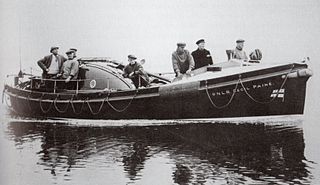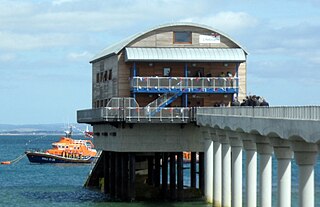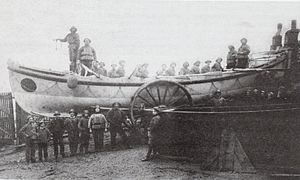
Padstow Lifeboat Station has been at Trevose Head west of Padstow, Cornwall, since 1967. Before that it was at Hawker's Cove on the Camel estuary between the town and the sea. The lifeboat station is run by the Royal National Lifeboat Institution (RNLI), and since 2006 has been the base for Tamar-class RNLB Spirit of Padstow.

Sheringham Lifeboat Station is an RNLI operated lifeboat station located in the town of Sheringham in the English county of Norfolk. Since 1992, the station has been inshore operations only – currently with an Atlantic 85 rigid inflatable – offshore lifeboats are to the east at Cromer and the west at Wells-next-the-sea.

The Augusta was a private lifeboat which was stationed in the town of Sheringham in the English county of Norfolk She was launched on 14 November 1838 and stayed on station for 56 years until she was retired from service in 1894 after an inspection declared her to be unseaworthy.

RNLB Lloyds II was an Oakley-class lifeboat of the Royal National Lifeboat Institution (RNLI) stationed at Sheringham in the English county of Norfolk from 8 October 1990 until April 1992, when she was replaced by the Atlantic 75 second generation Rigid Inflatable Boat (RIB) Manchester Unity of Oddfellows in April 1992. During the time that the Lloyds II was on station at Sheringham, she performed 13 service launches.

RNLB Benjamin Bond Cabbell II was a Cromer non self-righter type lifeboat stationed at Cromer Lifeboat Station in the English county of Norfolk from September 1884 until September 1902.

RNLB J C Madge was a Liverpool-class, Pulling and Sailing non-self righting lifeboat stationed at Sheringham in the English county of Norfolk from December 1904 until June 1936 during which time she was launched on service 34 times and saved 58 lives. J C Madge was replaced by Forester’s Centenary.

Wells-next-the-Sea Lifeboat Station is located at the end of Beach Road, about 1 mi (1.6 km) north of the town of Wells-next-the-Sea, on the north coast of the English county of Norfolk.

RNLB Foresters Centenary is a retired Liverpool-class lifeboat of the Royal National Lifeboat Institution (RNLI), stationed in the English coastal town of Sheringham in the county of Norfolk in the United Kingdom. The lifeboat was on station for 25 years between 1936 and 1961 when she was sold. She has been restored to her original condition and is exhibited in Sheringham Museum.

RNLB William Bennett was the second RNLI lifeboat to be stationed at the English seaside town of Sheringham in the county of Norfolk. She served the North Norfolk coast from 1886 until 1904. Her time at Sheringham was notorious for the difficulties she had during launch and retrieval to the lifeboat station which at this time was awkwardly placed in the centre of town.

RNLB Cecil Paine is a retired Liverpool-class non-self-righting lifeboat of the Royal National Lifeboat Institution. It was the second motor lifeboat to be stationed in the English coastal town of Wells-next-the-Sea in the county of Norfolk in the United Kingdom, and was on station at Wells from 25 July 1945 until she was sold in June 1965.
RNLB Manchester Unity of Oddfellows (B-702) was an Atlantic 75-class lifeboat rigid-inflatable inshore lifeboat on station at the English coastal town of Sheringham in the county of Norfolk in the United Kingdom. The boat was a permanent replacement for the Atlantic 21-class lifeboat RNLB B-536 which served at Sheringham from 29 January 1994.

Henry Ramey Upcher was the second private lifeboat to be stationed in the English town of Sheringham in the county of Norfolk. She was launched on 4 September 1894 and stayed on station for 41 years until she was slowly retired from duty and by 1935 had ceased rescue work completely. The lifeboat is now on permanent display in her converted original boat shed.

Hayling Island Lifeboat Station is located on the eastern side of Hayling Island, Hampshire, opposite the village of West Wittering, at the entrance to Chichester Harbour, where it joins the major shipping route of the Solent. This major shipping route is busy at all times of the year and there are estimated to be 10,000 boats in the Chichester area alone.

Selsey Lifeboat Station is a Royal National Lifeboat Institution (RNLI) station located in Selsey, West Sussex on the south coast of England.

Bembridge Lifeboat Station is located in the village of Bembridge on the Isle of Wight in the United Kingdom. The station is located on the eastern approaches to The Solent, south of the area known as Spithead. The station is on one of the busiest shipping lanes in United Kingdom waters. The main boathouse stands away from the shore on a piled platform with slipway, and is linked to the shore by a pier gangway.

Eastbourne Lifeboat Station is a Royal National Lifeboat Institution (RNLI) lifeboat station in the town of Eastbourne in East Sussex. Founded two years before the RNLI was established, the station has operated continuously since 1822, and its lifeboats have been responsible for saving over 700 lives.
The SS Commodore was a British-registered collier. She was built at Newcastle upon Tyne in 1870 and served with three companies. She was driven into shallow waters off Sheringham, Norfolk on 7 November 1896. Local fishermen tried to render assistance but were driven off by gale force winds. After the Commodore was driven onto rocks she sent a distress signal and the Sheringham lifeboat Henry Ramey Upcher took off all 14 crew and 3 stranded fishermen. The wreck was blown up in 1906 as a hazard to the Sheringham fishing fleet. The remains were exposed by storms in September 2021.

Blackrock Lifeboat Station is a former Royal National Lifeboat Institution (RNLI) station, located in the village of Blackrock, on the south side of Dundalk Bay, in County Louth, Ireland.

Worthing Lifeboat Station was located on Marine Parade, in the town of Worthing, in West Sussex.

New Romney Lifeboat Station was located across the northern end of Marine Parade, in-between St Andrew's Road and the Coastguard Station, at Littlestone-on-Sea, approximately 1 mile (1.6 km) to the east of New Romney town, on the southern Kent coast.



















